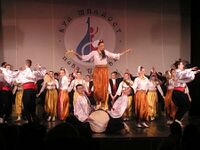KUD Mladost Nova Pazova
| File:ZNAK KUD-a - belo podloga.jpg Artistic Society Mladost Nova Pazova - Logo | |
| Formation | 1953 |
|---|---|
| Headquarters | Nova Pazova |
KUD Mladost Nova Pazova (Artistic Society Mladost Nova Pazova) is a Serbian cultural organisation established in 1953. Successfully operate in the gathering of young, developing tendency for the dance, song, music, plays, poetry, artistic creation, and above all the affirmation of cultural values of the Serbian people and other people who live in the territory of the Republic of Serbia. KUD Mladost NP is a member of the CIOFF Serbia Association since 2003.
Sections
- Small art workshop
- Drama club
- Folklore Section
- Women's singing group
- Folk dance Orchestra
Travel
National Folklore Ensemble and Orchestra traveled to:
- Poland
- Ukraine
- Slovakia
- Hungary
- Romania
- Bulgaria
- Macedonia
- Bosnia and Herzegovina (Serbian Republic)
- Slovenia
- Italy, Sicily
- Brazil
- Women's singing group traveled to:
- Slovakia
- Hungary
- Romania
- Bulgaria
- Bosnia and Herzegovina (Serbian Republic)
- Small art workshop traveled to Bitola (Macedonia).
The program of folk dance ensembles
- Performing folk dance ensemble:
| Serial number | Choreography | Choreographer | Musical Arrangement | Photo | Choreography description | Music or Video |
|---|---|---|---|---|---|---|
| 1. | The dances from Srem
Dance duration 7 minute |
Vladimir Spasojević | Saša Mazinjanin | File:Srem.jpg | String of dances and songs from Srem. showing the authentic costume from Srem, a large number of cheerful songs and dances from that area. | YouTube |
| 2. | Bunjevke dance
Dance duration 6 minute |
Branko Marković | Dušan Šaponja | File:Bunjevacke igre.jpg | Typical and popular dance from northern Vojvodina. Various folk dance-steps and typical music from the area. Weather-bells on dancers’ boots. Original and colourful costumes. | YouTube |
| 3. | Vlach dances
Dance duration 6 minute |
Milan Vujinović | Velja Cvetković | File:Vlaške igre 2003.jpg | Quick and temperament dance from the east Serbia. Show characteristic way of dancing in that area. | YouTube |
| 4. | Shumadija dances
Dance duration 6 minute |
Branko Marković | Dušan Šaponja | 
|
A medley of dances from the central part of Serbia. Jolly dances with small steps and floral costumes, typical for this region. | |
| 5. | Shopsko trojno
Dance duration 2 minute |
Branko Marković | Dušan Šaponja | File:Sopsko trojno.jpg | A dynamic dance of three boys, as a representation of the happy spirit of southeast Serbia. | |
| 6. | The dances from south-eastern Serbia – Bugarka
Dance duration 7 minute |
Vladimir Spasojević | Saša Mazinjanin | 
|
Temperament dances southeastern Serbia. Rally guys and girls who shows strength and endurance. | |
| 7. | The dances from Eastern Serbia - Timok
Dance duration 8 minute |
Dobrivoje Putnik | Borivoje Ilić | 
|
The dance comes from eastern Serbia. Shows the richness of costumes and music and history of the Serbian people. The leading guy fighting for the freedom of the people. | |
| 8. | Bulgarian dances
Dance duration 8 minute |
Dragomir Vuković | Petar Josimović | File:Vesele Sopske igre.jpg | ||
| 9. | The dances from Leskovac
Dance duration 8 minute |
Vladimir Spasojević | Saša Mazinjanin | File:Igre iz okoline Leskovca.jpg | ||
| 10. | The dances from Vranjsko Polje
Dance duration 8 minute |
Slaviša Đukić | Saša Mazinjanin | 
|
YouTube | |
| 11. | 'Lindio dance - a quick dance from Herzegovina
Dance duration 5 minute' |
Branko Marković | Dušan Šaponja | File:Lindjo.jpg | The geographical origin of the western Hercegovina. Mediterranean music and costumes show the mentality of the population, identified cheerful temperament. Crier as a function of the game, the witty way of issuing commands to other players, followed by a single instrument (Ljericom). | YouTube |
| 12. | The silent wheel - dance from Glamoch
Dance duration 6 minute |
Drago Kecman | / | |||
| 13. | Vranje suite
Dance duration 8 minute |
Branko Marković | Dragoljub Šarković | 
|
YouTube |
References
- Page KUD Mladost Nova Pazova on Facebook ((sr))
- Page KUD Mladost Nova Pazova on YouTube (Video)
- Page KUD Mladost Nova Pazova on Dailymotion (Video)
- CIOFF (international folklore organizations in UNESCO)